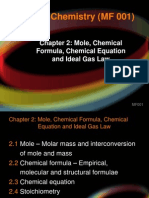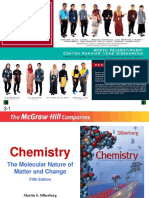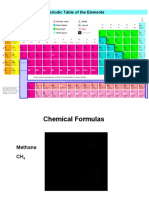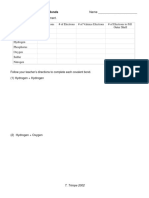2.2. Chemical Reactions
2.2. Chemical Reactions
Uploaded by
asfass sfasfasfasCopyright:
Available Formats
2.2. Chemical Reactions
2.2. Chemical Reactions
Uploaded by
asfass sfasfasfasCopyright
Available Formats
Share this document
Did you find this document useful?
Is this content inappropriate?
Copyright:
Available Formats
2.2. Chemical Reactions
2.2. Chemical Reactions
Uploaded by
asfass sfasfasfasCopyright:
Available Formats
CHEM 14 (2nd SEM: AY 14-15)
2.2.1. CHEMICAL REACTIONS Instructor: SM SIBUG
CHEMICAL REACTIONS: substances (reactants) get transformed into new substances
(products) by making and breaking chemical bonds
o Law of conservation of mass: Atoms are neither created nor destroyed during a
chemical reaction, merely rearranged
STOICHIOMETRY: the area of study that examines the quantities of substances consumed
and produced in chemical reactions
o Example: formation of water from O2 and H2
THE MOLE (mol): a quantity that describes the amount of substance by relating it to a
number of particles of that substance
1 mole = 6.022 x 1023 (Avogadro’s number, NA) of something
o A mole is equivalent to the number of particles as there are in exactly 12 grams of
carbon-12
MOLECULAR/FORMULA MASS (amu): the mass of 1 unit of compound
o The sum of the atomic masses of all constituent atoms
o Expressed in atomic mass units (amu): 1 amu = 1/12 of a carbon-12 atom
o Example: molecular mass of H2O
MOLAR MASS (g/mol): the mass of one mole of a substance
o amu/particle ≡ g/mol
Expressing amount of substance:
MASS (m) in MOLES (n) Number of
g in mol particles
PROBLEMS
Complete the following table, given that: H: 1.008 amu, C: 12.011 amu, N: 14.007 amu, O: 16.00 amu, Na: 22.99 amu,
Mg: 24.301 amu, S: 32.065 amu, Cl: 35.45 amu
Formula Molecular / Moles of Mass of Moles of Mass of # of atoms of
Formula Mass Sample Sample underlined underlined underlined
element element element
NaCl 25 g
CO 2.5 mol
2
CH 2.35 mg
3 8
MgCl 3.2 x 1022
2
Mg(OH) 0.88 mmol
2
(NH ) SO 3.3 x 10-2 g
4 2 4
Homework:
Mg(NO3)2 56.2 mg
C6H12O6 12.0 mmol
CHEM 14 (2nd SEM: AY 14-15)
2.2.1. CHEMICAL REACTIONS Instructor: SM SIBUG
EMPIRICAL vs MOLECULAR FORMULAS
o Empirical Formula: Shows the simplest ratio of one atom to another in the
compound
The first formula computed from % elemental composition (by mass) analysis
Note: for an ionic compound, the ionic formula is equivalent to the empirical
formula
Example: CH2O
o Molecular Formula: Shows the actual number of atoms of each type in one molecule
Example: from empirical CH2O, can have C2H4O2, C3H6O3, C6H12O6, etc.
(CH2O)n, where factor n = (molecular mass)/(empirical mass)
Examples:
Compound % Composition (by mass) Empirical Formula Molecular Mass Molecular Formula
Glucose 40.00% C, 6.71% H, 53.29% O 180.16 g/mol
Acetic Acid 40.00% C, 6.71% H, 53.29% O 60.05 g/mol
Chemical X 92.26% C, 7.74% H 78.11 g/mol
Method 1: Assume 100 g of sample Method 2: Assume 1 mole of sample
PROBLEMS
(a) Indigo, the dye used for blue jeans, has a percent composition, by mass, of 73.27% C, 3.84% H, 10.68% N, and the
remainder is oxygen. The molecular mass of indigo is 262.3 amu. What is the molecular formula of indigo?
(b) Chlorophyll contains 2.72% Mg by mass. Assuming one Mg atom per chlorophyll molecule, what is the molecular mass
of chlorophyll?
REPRESENTING CHEMICAL REACTIONS:
o BALANCING: Law of conservation of mass - no atoms must be lost or gained during
a chemical reaction
Add coefficients in front of reactants and products to balance the total
number of atoms on each side
Also note if reaction is a redox reaction! Apply half-reaction or oxidation
number method to balance
Example: “glucose combusts to yield carbon dioxide and water”
CHEM 14 (2nd SEM: AY 14-15)
2.2.1. CHEMICAL REACTIONS Instructor: SM SIBUG
STOICHIOMETRIC RELATIONSHIPS: a balanced chemical reaction gives the molar ratio of
products and reactants, and can be used to predict amounts of products produced or
reactants required
o Example: How many grams of O2(g) are required to combust 22.5 g of glucose?
o Combustion Analysis: an experimental method for establishing an empirical formula
for compounds that are easily burned, such as compounds containing C, H, O, N, S
A weighed sample is burned in the presence of O2(g), and the products,
H2O(g) and CO2(g) are weighed
Example: 2.54 g of a sample (MW 78.11 g/mol), containing only C and H, is
burned in excess oxygen, producing 8.59 g CO2 and 1.76 g H2O. What is the
molecular formula of the compound?
PROBLEM
(c) p-cresol is used as a disinfectant and in the manufacture of herbicides. A 0.4039 g sample of this carbon-hydrogen-
oxygen compound yields 1.1518 g CO2 and 0.2694 g H2O in combustion analysis. Its molecular mass is 108.1 amu. For
p-cresol, determine its (i) mass percent composition, (ii) empirical formula, (iii) molecular formula.
Limiting and Excess Reactant/Reagent:
o Limiting Reactant: the reactant that gets completely consumed in a reaction;
determines the quantity of products formed
o Excess Reactant: the reactant that does not get completely consumed; some is left
over after a reaction
o Example: The reaction of calcium hydride and water produces calcium hydroxide and
hydrogen as products. How many moles of H2(g) will be formed in the reaction between
0.82 mol CaH2(s) and 1.54 mol H2O(l)? Determine the moles of excess reagent as well.
Purity: some chemical reagents or samples are not 100% of a pure element/compound, but
may contain impurities
o In calculations involving a sample and a compound of interest, the mass of the
impurities
o Example: Determine the mass of H2(g) produced when 10.00 g of 97.1% pure CaH
reacts with water.
CHEM 14 (2nd SEM: AY 14-15)
2.2.1. CHEMICAL REACTIONS Instructor: SM SIBUG
Reaction Yield: Some reactions do not go to completion due to non-ideal conditions, side-
reactions, or equilibrium. Less product is formed than expected
o Theoretical Yield: the amount of a product formed, assuming that the reaction is
100% complete
o Actual Yield: the amount of a product formed in an experiment
o Example: In the reaction between 10.00 g 97.1% pure CaH and water, 0.201 g of H2
gas was produced. Determine the % yield of the reaction.
PROBLEMS
(d) Ammonia can be generated by heating together the solids NH 4Cl and Ca(OH)2. CaCl2 and H2O are also formed. (i) If a
mixture containing 33.0 g each of NH4Cl and Ca(OH)2 is heated, how many grams of NH3 will form? (ii) Which reactant
remains in excess, and in what mass?
(e) The reaction between Cr2O72- and HCl was used to prepare a small quantity of Cl2(g) in the laboratory. If a 62.6 g
sample that is 98.5% pure K2Cr2O7 was reacted with 325 mL of HCl(aq) with a density of 1.15 g/mL and 30.1 % HCl by
mass, how many grams of Cl2(g) was produced? [Hint: Cr2O72- gets reduced to Cr3+]
(f) In the reaction shown, 100.0 g of C6H11OH yielded 64.0 g C6H10. (i) What is the theoretical yield of the reaction? (ii)
What is the percent yield?
C6H11OH C6H10 + H2O
Homework
1) Dimethylhydrazine is a carbon-hydrogen-nitrogen compound used in rocket fuels. When burned in an excess of
oxygen, a 0.312 g sample yields 0.458 g CO2 and 0.374 g H2O. The nitrogen content of a 0.486 g sample is converted
to 0.226 g N2. What is the empirical formula of dimethylhydrazine?
Answer: CH4N
2) Solid silver oxide, Ag2O(s), decomposes at temperatures in excess of 300°C, yielding metallic silver and oxygen gas. A
3.13 g sample of impure silver oxide yields 0.187 g O2(g). What is the % purity of Ag2O in the sample? Assume that
Ag2O(s) is the only source of O2(g).
Answer: 86.5% Ag2O
3) The manufacture of ethyl alcohol, CH3CH2OH, yields diethyl ether (C2H5)2O, as a by-product. The complete
combustion of a 1.005 g sample of the product of this process yields 1.963 g CO2. What must be the mass percents of
ethyl alcohol and diethyl ether in this sample?
Answer: 90.73% ethyl alcohol
4) Warfarin, C19H16O4, is the active ingredient used in some anticoagulant medications. The amount of warfarin in a
particular sample was determined as follows: A 13.96 g sample was first treated with an alkaline I 2 solution to
convert C19H16O4 to CHI3. This treatment gives one mole of CHI3 for every mole of C19H16O4 that was initially present
in the sample. The iodine in CHI3 is then precipitated as AgI(s) by treatment with excess AgNO3:
CHI3(aq) + AgNO3(aq) + H2O(l) AgI(s) + HNO3(aq) + CO(g) (n.b.)
If 0.1386 g solid AgI were obtained, then what is the percentage by mass of warfarin in the sample analyzed?
Answer: 0.4346% warfarin
5) Chlorine can be generated by heating together calcium hypochlorite and hydrochloric acid. Calcium chloride and
water are also formed. (i) if 50.0 g Ca(OCl)2 and 58.96 g of HCl are allowed to react, how many grams of chlorine gas
will form? (ii) Which reactant, Ca(OCl)2 or HCl, remains in excess, and in what mass?
Answer: (i) 49.6 g Cl2, (ii) 7.96 g HCl in excess
6) How many grams of commercial acetic acid (97% CH3COOH by mass) must be allowed to react with an excess of PCl3
to produce 75.00 g of acetyl chloride (CH3COCl), if the reaction has 78.2% yield?
CH3COOH + PCl3 CH3COCl + H3PO3 (n.b.)
Answer: 75.6 g commercial acetic acid
You might also like
- Naming Chemical Compounds WorksheetDocument4 pagesNaming Chemical Compounds WorksheetSam Jo100% (1)
- Chem M4 PDFDocument9 pagesChem M4 PDFZarylle De AsasNo ratings yet
- 20171101131106chapter 5b - Mole and Stoichiometry PDFDocument50 pages20171101131106chapter 5b - Mole and Stoichiometry PDFShah100% (1)
- Chem Bio II Lecture 3 ReviewDocument29 pagesChem Bio II Lecture 3 ReviewKyrby CabalquintoNo ratings yet
- Exam 2 MaterialDocument56 pagesExam 2 Materialwixat61057No ratings yet
- Chap3lect 2020Document62 pagesChap3lect 2020Anonymous wt2BA7uNo ratings yet
- Stoich PDFDocument13 pagesStoich PDFJesza Mei GanironNo ratings yet
- Stoich PDFDocument13 pagesStoich PDFJesza Mei GanironNo ratings yet
- L4 5 StoichiometryDocument58 pagesL4 5 Stoichiometryandrea romeroNo ratings yet
- Chapter3 Mole ConceptDocument18 pagesChapter3 Mole Conceptaayush_vijayvargia100% (1)
- Principles of Chem STOICHIOMETRYDocument46 pagesPrinciples of Chem STOICHIOMETRYALIGARBES, Rhonna May L.No ratings yet
- Chem For Engineers ReviewerDocument11 pagesChem For Engineers ReviewerIsaac FontaronNo ratings yet
- 2ND Term S1 ChemistryDocument23 pages2ND Term S1 Chemistrygkylie0606No ratings yet
- IAL As Chemistry SN 4Document116 pagesIAL As Chemistry SN 4Michael J George100% (2)
- MOLE NotesDocument12 pagesMOLE NotesShanzay WaqarNo ratings yet
- Lecture 2 StoichiometryDocument52 pagesLecture 2 StoichiometryHiep NguyenNo ratings yet
- Unit-1 Some Basic Concepts of Chemistry Part-3Document26 pagesUnit-1 Some Basic Concepts of Chemistry Part-3ARYANNo ratings yet
- As LEVEL CalculationsDocument29 pagesAs LEVEL CalculationsbuseNo ratings yet
- MATTER (1.2 Mole Concept)Document101 pagesMATTER (1.2 Mole Concept)Supia NazmaNo ratings yet
- Chapter3 Mole ConceptDocument10 pagesChapter3 Mole Conceptmatyiman_123No ratings yet
- Empirical Molecular Formulas WKST KEY PDFDocument3 pagesEmpirical Molecular Formulas WKST KEY PDFMisbah TufailNo ratings yet
- Chapter 4 NotesDocument70 pagesChapter 4 Notesislamiconly431No ratings yet
- MF008 Fhs LNT 002 May11Document32 pagesMF008 Fhs LNT 002 May11Lim Shu YingNo ratings yet
- Chapter 1Document104 pagesChapter 1Sarathy Hari KumarNo ratings yet
- Orca Share Media1580335522780Document7 pagesOrca Share Media1580335522780elaine faithNo ratings yet
- Chapter # 1 ChemDocument3 pagesChapter # 1 ChemRana Hassan TariqNo ratings yet
- 5B - Stoichiometry 2Document41 pages5B - Stoichiometry 2Vimanan A/L S. VelangganiNo ratings yet
- Chemistry Xi 2011Document134 pagesChemistry Xi 2011Mini PGNo ratings yet
- General Chemistry 1: Stoichiometry1Document43 pagesGeneral Chemistry 1: Stoichiometry1Raymariz DamasoNo ratings yet
- Ch3 CompleteDocument48 pagesCh3 CompleteAN NGUYENNo ratings yet
- Chap 3Document67 pagesChap 3mariam_scitech8389No ratings yet
- Chapter 1: Fundamentals of Chemistry: Lesson 3: StoichiometryDocument6 pagesChapter 1: Fundamentals of Chemistry: Lesson 3: StoichiometryKristine Cris VenusNo ratings yet
- Ch3 CompleteDocument48 pagesCh3 CompleteAN NGUYENNo ratings yet
- 2.1 Mole Concept IDocument13 pages2.1 Mole Concept IAnisha Syazwana Binti RoslyNo ratings yet
- 11 - StoichiometryDocument6 pages11 - StoichiometryHassaan KhanNo ratings yet
- Chapter 3Document23 pagesChapter 3kuppler7967No ratings yet
- Lesson 8.3 Limiting and Excess ReagentDocument35 pagesLesson 8.3 Limiting and Excess ReagentGian Karlo VillanuevaNo ratings yet
- PearsonDocument12 pagesPearsonTrishNo ratings yet
- NOTES - 10.3 - Empirical - Molecular - Form - Slideshow - NEWDocument29 pagesNOTES - 10.3 - Empirical - Molecular - Form - Slideshow - NEWFaiz KhanNo ratings yet
- StiochiometryDocument11 pagesStiochiometryIndrojyoti MondalNo ratings yet
- Lecture 5 Introduction To ReactionsDocument53 pagesLecture 5 Introduction To ReactionsM MubeenNo ratings yet
- Gen Chem 1 Lesson 4Document26 pagesGen Chem 1 Lesson 4kayemywife8No ratings yet
- Stoichiometry: Calculations With Chemical Formulas and EquationsDocument20 pagesStoichiometry: Calculations With Chemical Formulas and EquationsIan Marve ValNo ratings yet
- Topic 1 Stoichiometry and Solution ConcentrationDocument48 pagesTopic 1 Stoichiometry and Solution ConcentrationSheau Huey ChenNo ratings yet
- Chapter 9 Powerpoint Notes 2008Document39 pagesChapter 9 Powerpoint Notes 2008Umar AsimNo ratings yet
- XI Chemistry Chapterwise Advanced Study MaterialDocument537 pagesXI Chemistry Chapterwise Advanced Study MaterialregisNo ratings yet
- 03 - Lecture (20110920)Document62 pages03 - Lecture (20110920)Alfaiz Radea Arbianda100% (1)
- GENERAL CHEMISTRY (Stoichiometry)Document58 pagesGENERAL CHEMISTRY (Stoichiometry)ARDENNo ratings yet
- Lecture 2 StoichiometryDocument45 pagesLecture 2 StoichiometryKalinda MondeNo ratings yet
- Physical Science: First Quarter - Module 6: StoichiometryDocument38 pagesPhysical Science: First Quarter - Module 6: StoichiometryLee Arne BarayugaNo ratings yet
- Chap3lect 2009Document53 pagesChap3lect 2009afaflotfi_155696459No ratings yet
- MolesDocument9 pagesMolesRobert mukwekweNo ratings yet
- Stochiometry Grade 9th Short Note For Grade 12thDocument8 pagesStochiometry Grade 9th Short Note For Grade 12thWesNo ratings yet
- 2ND Term SS1 Chemistry NoteDocument23 pages2ND Term SS1 Chemistry Notemystery mysteryNo ratings yet
- IbchstoichDocument11 pagesIbchstoichapi-293306937No ratings yet
- Practice Makes Perfect in Chemistry: Oxidation-ReductionFrom EverandPractice Makes Perfect in Chemistry: Oxidation-ReductionRating: 5 out of 5 stars5/5 (1)
- Practice Makes Perfect in Chemistry: Oxidation-Reduction with AnswersFrom EverandPractice Makes Perfect in Chemistry: Oxidation-Reduction with AnswersNo ratings yet
- Alphabetical List of The Elements PDFDocument1 pageAlphabetical List of The Elements PDFSiddhartha PachisiaNo ratings yet
- Method 365.3: Phosphorous, All Forms (Colorimetric, Ascorbic Acid, Two Reagent)Document5 pagesMethod 365.3: Phosphorous, All Forms (Colorimetric, Ascorbic Acid, Two Reagent)Ahmed IsmailNo ratings yet
- 2010krivits Acs PrintDocument35 pages2010krivits Acs PrintSorin BorsaNo ratings yet
- CHE 254 1 Homework 14 - Chapter 4Document2 pagesCHE 254 1 Homework 14 - Chapter 4tsbertalanNo ratings yet
- SEM 1 Chapter ReviewDocument22 pagesSEM 1 Chapter ReviewthrrishaNo ratings yet
- Periodic Table IPEDocument15 pagesPeriodic Table IPEAdiChemAdi100% (4)
- Ionic Equilibria SolutionsDocument11 pagesIonic Equilibria SolutionssaffronNo ratings yet
- Chemical Bonding Part - 1 by Kuldeep SirDocument208 pagesChemical Bonding Part - 1 by Kuldeep SirMasoodNo ratings yet
- AQA Chemistry (P 1) June 2018 MSDocument21 pagesAQA Chemistry (P 1) June 2018 MSOmar HafezNo ratings yet
- Covalent Bond Worksheet PDFDocument4 pagesCovalent Bond Worksheet PDFHelma Jabello AriolaNo ratings yet
- EmasDocument46 pagesEmasNanda Rizky50% (2)
- Dod-Std-1866 1981Document30 pagesDod-Std-1866 1981Anonymous SA14VdrNo ratings yet
- Chapter 12 - StoichiometryDocument50 pagesChapter 12 - Stoichiometryapi-256257174No ratings yet
- Hydrogen JEEDocument77 pagesHydrogen JEERohith Kumar100% (1)
- TSX Listed Companies Nov-2018Document604 pagesTSX Listed Companies Nov-2018Chetan ParmarNo ratings yet
- 16 Water ChemistryDocument21 pages16 Water ChemistryMohit KambojNo ratings yet
- Lead-Free Perovskite Review (2305843009214365758)Document16 pagesLead-Free Perovskite Review (2305843009214365758)Thanh Long TaNo ratings yet
- Article - Chromium PlatingDocument12 pagesArticle - Chromium Platingfauzi7No ratings yet
- The Mole Concept - PART 1: CAPE Chemistry - Unit 1Document30 pagesThe Mole Concept - PART 1: CAPE Chemistry - Unit 1Kristy SamarooNo ratings yet
- The Beneficiation of Antimony Ore by FlotationDocument4 pagesThe Beneficiation of Antimony Ore by FlotationSimi SichulaNo ratings yet
- Sub Topic - Iv. Poly Halogen Compounds: Halo Alkanes and HaloarenesDocument3 pagesSub Topic - Iv. Poly Halogen Compounds: Halo Alkanes and HaloarenesmsNo ratings yet
- FY - PA I - Redox TitrationDocument35 pagesFY - PA I - Redox TitrationKaran PathakNo ratings yet
- General ChemistryDocument48 pagesGeneral ChemistryJustine Kei Lim-OrtegaNo ratings yet
- Excel Chemistry TextbookDocument72 pagesExcel Chemistry TextbookLivis EyoreNo ratings yet
- B001 Arihant PDFDocument12 pagesB001 Arihant PDFmathclubNo ratings yet
- High-Temperature Metals and Alloys Chlorine Corrosion ofDocument6 pagesHigh-Temperature Metals and Alloys Chlorine Corrosion ofkaldjdsjkaNo ratings yet
- Silver Mirror TestDocument3 pagesSilver Mirror TestBa'ist Khaerul100% (1)
- Mole Concept AssignmentDocument14 pagesMole Concept AssignmentmunasinghNo ratings yet
- Sold N BrazeDocument14 pagesSold N Brazeanju_akhil20071656No ratings yet

























































































